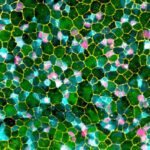Link to Pubmed [PMID] – 17304529
Dev. Dyn. 2007 Apr;236(4):1072-84
To gain knowledge about the developmental origin of serotonergic precursors and the regulatory cascades of serotonergic differentiation in vertebrates, we determined the spatiotemporal expression profile of the Ets-domain transcription factor-encoding gene pet1 in developing and adult zebrafish. We show that it is an early, specific marker of raphe serotonergic neurons, but not of other serotonergic populations. We then use pet1 expression together with tracing techniques to demonstrate that serotonergic neurons of rhombomeres (r) 1-2 largely originate from a progenitor pool at the midbrain-hindbrain boundary. Furthermore, by combining expression analyses of pet1 and the raphe tryptophan hydroxylase (Tph2) with rhombomere identity markers, we show that anterior and posterior hindbrain clusters of serotonergic precursors are separated by r3, rather than r4 as in other vertebrates. Our findings establish the origin of r1-2 serotonergic precursors, and strengthen the evidence for molecular, ontogenic and phylogenic heterogeneities among the vertebrate brain serotonergic cell populations.

